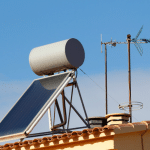Shedding Light on Solar Street Lights in Australia: Understanding How They Work
Solar street lighting is a rapidly growing sector within the renewable energy landscape, offering an environmentally friendly and cost-effective alternative to traditional street lighting. These systems harness solar energy to provide illumination for streets, parks, and remote areas, reducing reliance on the conventional power grid and contributing to a greener planet. This article delves deep into the workings, benefits, and challenges of solar street lighting, providing a comprehensive understanding of its components, installation, and maintenance.
“There are approximately 2.28 million street lighting lamps in service in Australia, with around 33% on main roads and 67% on local roads. ” (source: Energy Ratings)
Understanding the Components of Solar Street Lights
Solar street lights consist of several key components, each playing a vital role in the system’s efficiency and functionality:
- Solar Panels: These panels capture the sun’s energy and convert it into electricity.
- Batteries: Typically lithium-ion or lead-acid, these store electricity for use during the night.
- LED Lights: Energy-efficient lights that provide bright illumination.
- Controllers: These regulate the power, ensuring optimal charging and discharging of the battery.
- Poles and Fixtures: Support structures that hold the lights, panels, and sometimes, battery units.
The Science Behind Solar Street Lights
The core technology behind solar street lights is the photovoltaic effect. Solar panels are composed of photovoltaic cells made from semiconductor materials like silicon. When sunlight hits these cells, it causes electrons to be knocked loose, moving through the material to produce direct current (DC) electricity. This electricity is then converted to alternating current (AC) or used directly to charge the system’s batteries.
Solar Street Lighting: Energy Storage and Management
Efficient energy storage and management are crucial for the reliability of solar street lights. The system’s controller plays a key role here, managing the energy flow between the solar panels, battery, and the light. It ensures the battery is charged during the day and prevents overcharging, which can reduce battery lifespan. At night, the controller releases the stored energy to power the LED lights, providing consistent and reliable lighting.
Comparative Analysis: Solar vs. Traditional Street Lighting
Solar street lights offer several advantages over traditional grid-connected lights:
- Cost-Efficiency: While the initial setup cost of solar street lights can be higher, the long-term savings on electricity bills and low maintenance costs make them a cost-effective solution.
- Environmental Impact: Solar street lights produce no emissions, significantly reducing the carbon footprint compared to traditional lighting that relies on fossil fuels.
- Flexibility: They can be installed in remote or off-grid areas where traditional lighting would be impractical or too expensive to install.
Economic Benefits of Solar Street Lights
The adoption of solar street lighting systems can drive significant economic benefits, including:
- Reduced Energy Costs: Municipalities and businesses can dramatically reduce their energy expenditures.
- Job Creation: The installation and maintenance of solar street lighting systems provide new jobs in technology and engineering sectors.
Environmental Impact of solar street lighting
Switching to solar street lights helps combat climate change by decreasing the amount of CO2 and other harmful pollutants released into the atmosphere. It also reduces the strain on non-renewable energy sources, making urban environments cleaner and more sustainable.
Installation of solar street lights – The Process
Installing solar street lights involves several steps:
- Site Survey: Assessing the location for solar potential and deciding the positioning of each component.
- Mounting Solar Panels: These are typically mounted on poles or rooftops facing south (in the Northern Hemisphere) to maximize sunlight exposure.
- Setting Up Batteries and Controllers: Securely installing the batteries and controllers to protect them from environmental factors.
- Light Installation: Attaching the LED lights to the poles and connecting them to the batteries and solar panels.
Maintenance and Durability of solar street lights
Solar street lights require minimal maintenance, which typically includes:
- Cleaning Solar Panels: Regular cleaning to maintain high efficiency.
- Battery Checks: Ensuring connections are secure and the battery is in good health.
- Light Replacements: LED lights last a long time but may eventually need replacing.
Technological Advancements in Solar Street Lighting
Recent advancements include the integration of smart technology into solar street lights, such as:
- Motion Sensors: To adjust the brightness based on the presence of pedestrians or vehicles.
- Remote Monitoring: Allowing real-time tracking of the system’s performance and quick identification of issues.
Legal and Regulatory Framework
The adoption of solar street lighting is often supported by government incentives, such as subsidies or grants, which help reduce the initial investment costs and encourage urban and rural communities to transition towards sustainable energy solutions.
Challenges and Solutions
Despite their benefits, solar street lights face challenges such as:
- Theft and Vandalism: Secure installation techniques and robust materials help mitigate these issues.
- Weather Reliability: Advanced battery solutions and weather-resistant components ensure consistent performance.
Solar Street Lights – Future Prospects
The future of solar street lighting looks promising with ongoing innovations that promise higher efficiencies, lower costs, and enhanced capabilities. As technology progresses, the scalability of solar street lights is set to increase, paving the way for wider adoption.
FAQs:
- What is the average cost of a solar street light system?
- The cost can vary widely based on factors such as the quality of components and the scale of the project. Typically, prices range from $200 to $1,000 per light.
- How do weather conditions affect the efficiency of solar street lights?
- Solar street lights are designed to be robust and can operate in various weather conditions; however, their efficiency can decrease during prolonged periods of overcast weather.
- What are the latest technological innovations in solar street lighting?
- Innovations include the integration of smart controls, wireless connectivity, and improved photovoltaic cells that offer higher efficiency.
- How can local governments support the adoption of solar street lighting?
- Governments can offer financial incentives, streamline permitting processes, and include solar lighting in urban planning guidelines.
- What are the most common maintenance issues with solar street lights?
- Common issues include battery replacement, panel cleaning, and occasional LED failures.
Sources: Orca Solar Lighting Commercial Street Lights
Read more about commercial solar street lights
Enlightened Choices: Exploring the Benefits of Commercial Solar Street Lights in Australia
Shedding Light on Solar Street Lights in Australia: Understanding How They Work








